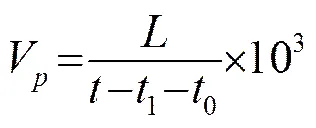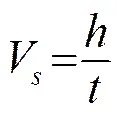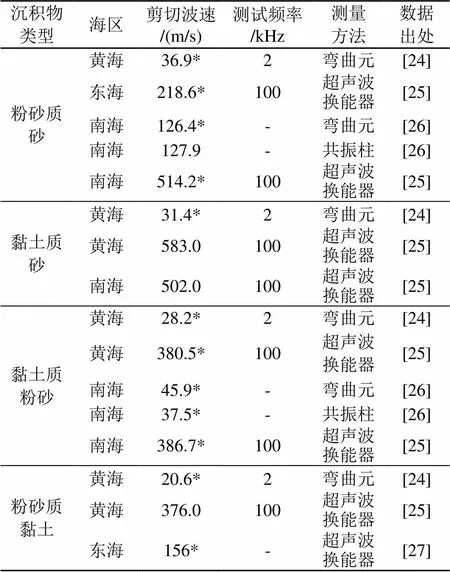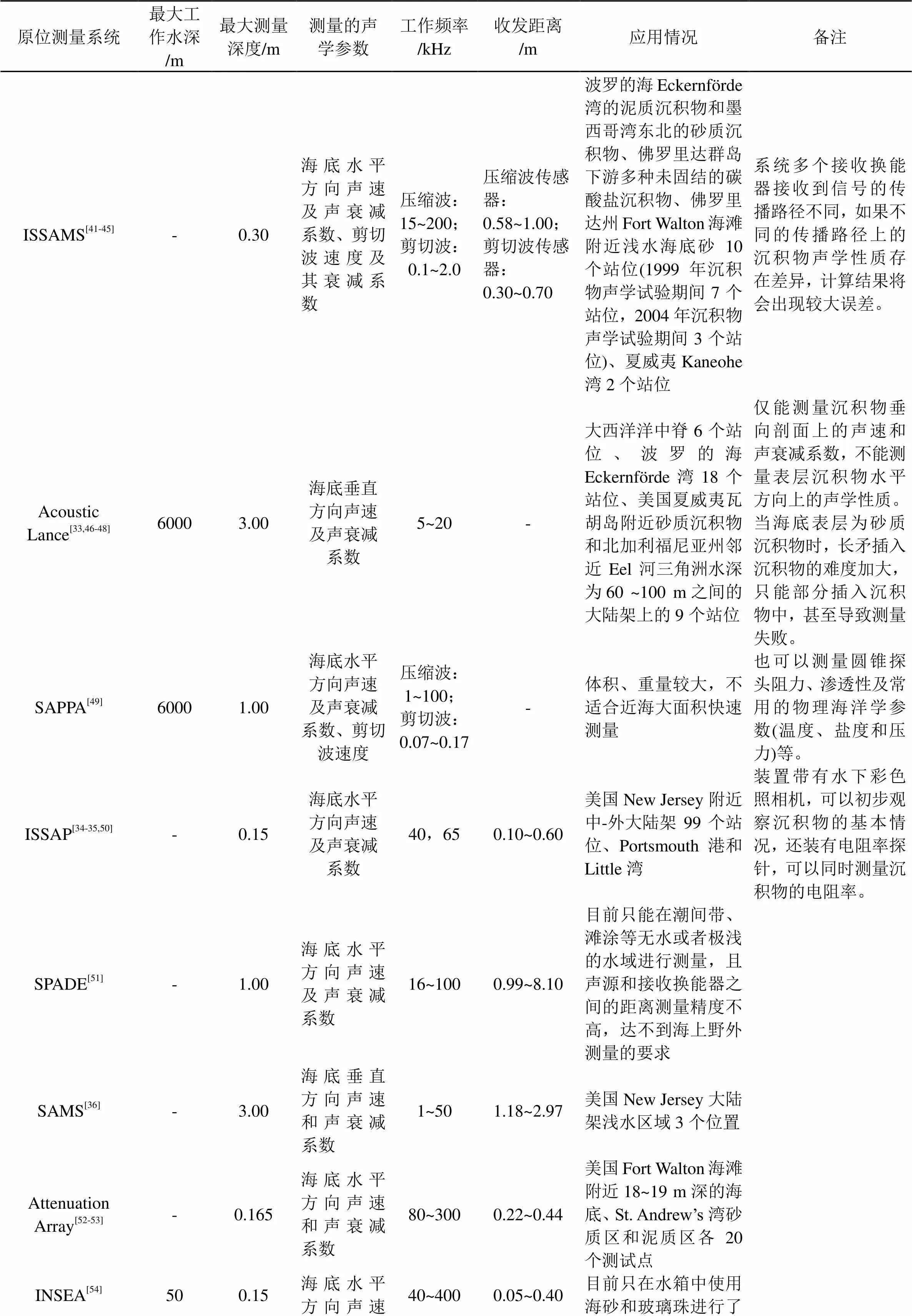海底沉积物声学性质测量技术评述
2016-10-13孟祥梅孙蕾
孟祥梅,孙蕾
海底沉积物声学性质测量技术评述
孟祥梅1,2,孙蕾1,2
(1. 海洋沉积与环境地质国家海洋局重点实验室,国家海洋局第一海洋研究所,山东青岛 266061; 2. 青岛海洋科学与技术国家实验室海洋地质过程与环境功能实验室,山东青岛 266061)
由于资源勘探、军事应用、岩土特性声学调查和声波传播理论研究等的需要,多年来人们一直在进行海底沉积物声学性质的测量。对海底沉积物声学性质的取样测量技术和原位测量技术进行了叙述,分别总结了两种测量技术存在的问题,认为下一步有必要发展海底沉积物低频声学性质的直接测量技术,建议在原位测量海底沉积物声学性质参数的同时测量其他性质参数以便于对比研究,并设法提高原位测量的工作效率。
海底沉积物;声学性质;取样测量;原位测量
0 引言
海底沉积物声学性质参数,例如声波在沉积物中传播的速度和衰减,是沉积物声波传播理论的基本输入参数。自从20世纪50年代以来,为了以下目的,声波在松散沉积物中传播的速度和衰减就已被测量[1-9]:(1) 约束低频地球物理学数据的反演,特别是与油气勘探有关的数据;(2) 为反潜战提供地声学模型;(3) 测定岩土特性与声学特性之间的关系以支持声学调查技术;(4) 研究声波传播理论公式的正确性;(5) 预测沉积物的岩土性能;(6) 为高频散射和穿透模型提供必要的输入参数。
海底沉积物声学性质测量技术主要分三种,即取样测量、反射/折射剖面遥测和原位测量。
取样测量由于技术简单,样品的外界因素如压力和温度可控,很长时间内一直是海底沉积物声学性质测量的主要方法。但由于在取样、运输、保存和测试过程中,海底沉积物样品会受到未知程度的扰动,内部结构势必发生变化,从而影响声学性质的测量结果,而有限的典型样品尺寸也会限制用于样品测试的频率。
大规模海底沉积物声速调查在测量原理上主要有反射波法和折射波法两种,它是利用人工地震波在地层中的传播规律获取地层信息的方法。测定不同水平距离上的直达波、反射波和首波的传播时间,根据折射定律,计算底质中各层的声速和厚度。由直达波和反射波的传播路径及声能之差可决定各层沉积物的衰减系数。反射/折射剖面遥测技术为测量大体积表层和次表层沉积物的原位声学性质提供了一个高效的方式。该技术的弊端是被声穿透的沉积物体积存在一定程度的不确定性,而采用的数据处理技术需要确定的假设,这可能限制它们对某些沉积物类型的使用。
原位测量是介于取样测量和反射/折射剖面遥测之间的一种折衷的技术,虽然其与遥测技术相比更具侵入性,但比取样测量受扰动小。与原位声波传播试验相关的试样几何形状比实验室技术受限制少,而且与遥测技术相比能更好地描述海底沉积物的声学性质。
总的来说,反射/折射剖面遥测技术提供的是大体积地层的平均声速和衰减系数的估计,属于获取海底沉积物声学性质的间接方法,而取样测量和原位测量属于直接方法,本文仅对这两种测量技术进行评述。
1 取样测量
1.1 声速和声衰减测量
在实验室中通常采用透射法测量沉积物的声速,测量原理如图1所示,发射换能器产生的声波在海底取得的沉积物样品中传播,被另一端的接收换能器接收。在已知样品长度的情况下,根据声波仪记录的接收信号计算出声波穿透时间,由式(1)即可得声速:

其中:V为样品声速(m/s),为样品长度(mm),为声波穿透时间(μs),1为系统延时(μs),0为声时修正值(μs)。
图1 声速透射法测量原理图
Fig.1 Schematic of transmission measurement of acoustic velocity
上述测量方法测量的是海底沉积物样品垂直方向上的声速。Richardson[10]发明的方法测量的是海底沉积物样品径向上的声速和衰减系数:根据分别在沉积物岩芯中和充满蒸馏水的相同岩芯管中传播的频率为400 kHz声波信号(5~10个周期的正弦波)的传播时间差(D)来测量声速(,m/s)和衰减系数(,dB/m)

(3)
其中:w是蒸馏水的声速(m/s);是岩芯管的内径(m);w/s是沉积物蒸馏水中与样品中透射声波振幅的接收电压的比值。另外,多传感器跟踪系统[11]及岩芯综合测试系统[12-16]上带的P波传感器也可用来测量海底沉积物样品径向上的声速,方法与Richardson的方法类似。
邹大鹏等[17]提出了同轴差距衰减测量法(其原理图如图2所示),并推导得出了衰减系数α的表达式:

其中:1、2分别为样品长度为1、2时接收到的声波信号的声压最大幅值。
图2 同轴差距衰减测量法原理图
Fig.2 Schematic of coaxial differential distance measurement of acoustic attenuation
1.2 剪切波速测量
在实验室中,沉积物剪切波速的测量采用多种技术,包括共振柱、使用石英晶体传感器的脉冲技术、压电陶瓷剪切板或径向膨胀传感器、扭转共振柱[18]、扭转周期载荷及多种压电陶瓷或弯曲元(见Bennell和Taylor-Smith[19]的回顾)。弯曲元可以被悬臂安装,其中弯曲元的一端被夹紧,允许另一端振动[20-21]或将其自由地嵌入一种柔性材料中[22-23]。悬臂安装对实验室测量来说最合适,且自由嵌入对原位应用来说更好。
目前在实验室中通常使用弯曲元法对沉积物的剪切波速进行测试(如图3所示)。试验时,弯曲元悬臂段被插入试样中。当一端的弯曲元通电而产生弯曲运动时周围的土体也被迫水平向左右运动。这种运动以波的形式通过土体这一介质传播,到达另一端时,对端的弯曲元由于周围土体的运动而产生弯曲变形,由于压电材料的特殊性质,动能转变为电能,该电信号被电荷放大器接收并放大。用示波器记录激发和接收两种信号。试样中剪切波波速可用式(5)得出:

其中:V为剪切波速(m/s);为修正后的试样高度(mm),即试样的高度减去弯曲元插入试样的高度,为剪切波传播时间(ms),即激发和接收信号的时间差。
图3 弯曲元法测试沉积物剪切波速示意图
Fig.3 Schematic of shear wave speed measurement using bending element method
1.3 目前取样测量技术存在的问题
从海底取得沉积物样品进行声学性质测量改变了海底沉积物的赋存环境,虽然可以通过实验手段恢复海底的压力和温度等,但是由于海底沉积物并非理想弹性体,其在取样、运输、保存和测试过程中产生的形变并不能完全恢复,这势必影响声学性质的测量结果(见图4和图5)。另外,前述声衰减测量方法换能器与沉积物之间耦合欠佳引起的能量损失、分割样品造成的扰动、边界散射的干扰连同上述海底沉积物状态的改变使得取样测量得到的声衰减系数远远大于原位测量的结果[24](见图5)。同样是取样测量使用不同测量方法测得的剪切波速也不一样(见表1)。从表1来看,使用超声波换能器测得的剪切波速明显偏大,而使用弯曲元和共振柱测得的剪切波速比较一致。

表1 不同取样测量方法测得的海底沉积物剪切波速比较
* 表示该数据为平均值
2 原位测量
2.1 国内外原位测量系统
针对海底沉积物声学性质参数的测量问题,国外研究者率先研制了各种原位测量系统,工作时系统被下放到海底,换能器插入沉积物中直接对声学性质进行测量,获取相应的声学参数。声速一般根据测量得到的声波传播时间和探针之间的距离来直接计算,或通过与声波在海水中的传播相对比而得到。声衰减系数通常由不同距离探针间的声波能量(波形振幅)损失与标准能量(如海水中的振幅)相对比得到。有的测量系统还安装有剪切波换能器,与声速和声衰减的测量原理一致,通过接收到的信号的到达时间和振幅的变化,计算不同接收换能器之间沉积物的剪切波速度及其衰减。有的测量系统可以附在重力取样器、活塞取样器或专门设计的探针上,通过各个接收换能器接收到信号的到达时间和振幅差异,计算换能器之间的垂向剖面上沉积物的声速和衰减系数。
最早用于海底沉积物声学性质原位测量的是安装有两个钛酸钡传感器的探针[28],其由携带水中呼吸器的潜水员插入水下沉积物表层以下6 in (15.24 cm),通过测量两个传感器之间声能脉冲的传播时间得到原位声速,随后又借助深潜器使仪器工作在1200 m水深海底[29]。Allman[30]制作了一种电缆控制水下载体,现场测量沉积物的声速和声衰减。Shirley和Anderson[31]制作了附加在普通取样器上的声速剖面仪,但取样器插入海底的初速度约为5 m/s,表层样品受扰动,换能器和沉积物相对运动较快,彼此耦合弱,降低了沉积物中的信号强度。
早期的工作通过一些原位设备的发展和使用得到了加强,这些原位测量系统主要包括美国海军研制的ISSAMS[32]、夏威夷大学研制的进行沉积物垂直剖面声学性质测量的Acoustic Lance[33]、新罕布什尔大学研制的ISSAP[34-35]及华盛顿大学设计的SAMS[36]等。
国内在海底沉积物声学性质原位测量技术方面要滞后于国外,近些年各单位也开始研制相应的测量设备,如国家海洋局第二海洋研究所研制的实时监控多频海底声学原位测试系统[37]、中国科学院海洋研究所研制的海底沉积物声学性质原位测量系统[38]、国家海洋局第一海洋研究所研制的基于液压驱动贯入的自容式海底沉积物声学原位测量系统[39]和便携式海底沉积物声学原位测量系统[40]等。
表2列出了见诸文献的海底沉积物声学性质原位测量系统的工作参数及应用情况等。从表2来看,大部分原位测量系统测量的是海底水平方向沉积物的声学参数,最大测量深度为1.20 m;Acoustic Lance、SAMS和实时监控多频海底声学原位测试系统测量的是海底垂直方向沉积物的声学参数,最大测量深度为8.00 m。表2中所列的12个原位测量系统均可测量海底沉积物的声速及声衰减系数,ISSAMS及SAPPA还可测量海底沉积物的剪切波速度,而ISSAMS也可测量剪切波的衰减系数。表2中各个原位测量系统测量声速的工作频率均在1 kHz以上,其中ISSAP、Attenuation Array、INSEA、海底沉积物声学性质原位测量系统、基于液压驱动贯入的自容式海底沉积物声学原位测量系统和便携式海底沉积物声学原位测量系统的工作频率均在20 kHz以上(超声波),Acoustic Lance的工作频率均在20 kHz以下。表2中除SPADE外,用于海底水平方向沉积物声学性质测量的原位测量系统测量声速的传感器收发距离最大为1.27 m,最小为0.10 m,用于海底垂直方向沉积物声学性质测量的SAMS收发距离介于1.18 m至2.97 m之间。从应用情况来看,表2中的原位测量系统主要用于浅海环境中海底沉积物声学性质的测量。国外原位测量系统中除SAPPA、SPADE和INSEA外其余均已用于海底沉积物声学性质的野外调查。国内原位测量系统中基于液压驱动贯入的自容式海底沉积物声学原位测量系统,由于其通过液压驱动贯入,减少了对沉积物的扰动,并可按照预设的工作参数在海底全自动工作,已用于海底沉积物声学性质的野外调查。

表2 国内外海底沉积物声学性质原位测量系统
*“-”表示未查到该项数据。需要注意的是,国内外海底沉积物声学性质原位测量系统可能会因国防需要资料不公开,表2中仅包含作者搜集到的公开中英文文献中提到的设备。
2.2 目前原位测量技术存在的问题
原位测量与取样测量相比不改变海底沉积物的赋存环境,海水是换能器与沉积物之间的天然耦合剂,测量时对沉积物的扰动也小,相比反射/折射剖面遥测更准确,因此国内外一直在竞相研制原位测量系统。但是,目前的原位测量系统大多仅能进行海底沉积物声学性质的测量,不能同时进行物理力学性质的测量,与取样测量相比,不便于海底沉积物声学性质与物理力学性质的对比研究。另外,除中国科学院海洋研究所研制的原位测量系统实现了拖行式连续测量[56-57]外,其余原位测量系统一次仅能测量一个站位海底沉积物的声学性质,不便于进行大范围海底沉积物声学性质调查。目前国内的原位测量系统中除实时监控多频海底声学原位测试系统有多个工作频率外,其余原位测量系统的工作频率只有一个,不利于测量结果的应用。
3 总结
目前来看,无论是取样测量技术还是原位测量技术,受样品尺寸或原位测量系统尺寸限制,测试频率一般都较高。由于声波在海底沉积物中传播衰减的非线性,取样测量或原位测量测得的声衰减数据无法应用于低频的油气勘探或地声学模型,反射/折射剖面遥测技术的测试频率虽然较低,但是属于间接方法,有必要发展海底沉积物低频声学性质的直接测量技术。另外,为了促进海底沉积物声学性质原位测量数据在岩土特性声学调查中的应用,应在测量声学性质参数的同时测量海底沉积物的其他性质参数进行对比研究,并进一步发展类似于拖行式连续测量的原位测量系统以提高测量效率。
[1] Hamilton E L, Shumway George, Menard H W, et al. Acoustic and other physical properties of shallow-water sediments off San Diego[J]. The Journal of the Acoustical Society of America, 1956, 28(1): 1-15.
[2] 梁元博, 卢博. 海洋沉积物及其声学物理性质的研究[J]. 海洋地质研究, 1981, 1(2): 28-37.
LIANG Yuanbo, LU Bo. Marine sediments and their acoustic-physical properties[J]. Marine Geological Research, 1981, 1(2): 28–37.
[3] LIANG Yuanbo, LU Bo. On the effect of physico-geotechnical characteristics upon sound velocities of sea floor sediments[J]. Acta Oceanologica Sinica, 1984, 3(3): 313-320.
[4] LU Bo, LI Ganxian, HUANG Shaojian. Acoustic-physical properties of calcareous seafloor soils and their significance in engineering geology[J]. China Ocean Engineering, 2000, 14(3): 361-370.
[5] 孟祥梅, 刘保华, 阚光明, 等. 南黄海海底沉积物声学特性及其影响因素试验研究[J]. 海洋学报, 2012, 34(6): 74-83.
MENG Xiangmei, LIU Baohua, KAN Guangming, et al. An experimental study on acoustic properties and their influencing factors of marine sediment in the southern Huanghai Sea[J]. Acta Oceanologica Sinica, 2012, 34(6): 74-83.
[6] LIU Baohua, HAN Tongcheng, KAN Guangming, et al. Correlations between the in situ acoustic properties and geotechnical parameters of sediments in the Yellow Sea, China[J]. Journal of Asian Earth Sciences, 2013, 77(21): 83-90.
[7] ZOU Dapeng, YAN Pin, ZHOU Jianping. Research on acoustic properties of seafloor sediment with temperature and pressure controlled[J]. Marine Georesources & Geotechnology, 2014, 32(2): 93-105.
[8] 李赶先, 龙建军. 南海南部海域岛礁区海底珊瑚砂声速影响因素的初步研究[J]. 海洋学报, 2014, 36(5): 152-160.
LI Ganxian, LONG Jianjun. A preliminary study of the sound velocity influence factors of submarine coral sand of islands sea area in southern South China Sea[J]. Acta Oceanologica Sinica, 2014, 36(5): 152-160.
[9] McCann C, Sothcott J, Best A I. A new laboratory technique for determining the compressional wave properties of marine sediments at sonic frequencies and in situ pressures[J]. Geophysical Prospecting, 2014, 62(1): 97-116.
[10] Richardson M D. Spatial variability of surficial shallow water sediment geoacoustic properties[M]//Akal T, Berkson J M. Ocean Seismo-Acoustics. London: Plenum Press, 1986: 527-536.
[11] Shipboard Scientific Party. Explanatory Notes[C]//Curry W B, Shackleton N J, Richter C, et al. Proceedings of the Ocean Drilling Program, Initial Reports, 154. College Station (TX): ODP, 1995: 11-38.
[12] Weaver P P E, Schultheiss P J. Current methods for obtaining, logging and splitting marine sediment cores[J]. Marine Geophysical Research, 1990, 12(1-2): 85-100.
[13] Schultheiss P J, Weaver P P E. Multi-sensor core logging for science and industry[C]//Mastering the Oceans Through Technology: Proceedings of Oceans ’92, 2. Newport (RI): 1992: 608-613.
[14] Weber M E, Niessen F, Kuhn G, et al. Calibration and application of marine sedimentary physical properties using a multi-sensor core logger[J]. Marine Geology, 1997, 136(3-4):151-172.
[15] Gunn D E, Best A I. A new automated nondestructive system for high resolution multi sensor core logging of open sediment cores [J]. Geo-Marine Letters, 1998, 18(1):70-77.
[16] Best A I, Gunn D E. Calibration of marine sediment core loggers for quantitative acoustic impedance studies[J]. Marine Geology, 1999, 160(1-2): 137-146.
[17] 邹大鹏, 卢博, 吴百海, 等. 基于同轴差距测量法的南海深水海底沉积物声衰减特性研究[J]. 热带海洋学报, 2009, 28(3): 35-39.
ZOU Dapeng, LU Bo, WU Baihai, et al. Acoustic attenuation characteristics of deep-water seafloor sediments from the South China Sea based on coaxial differential distance attenuation measurement method[J]. Journal of Tropical Oceanography, 2009, 28(3): 35-39.
[18] Davis A M, Bennell J D. Dynamic properties of marine sediments [M]//Akal T, Berkson J M. Ocean Seismo-Acoustics. New York: Plenum Press, 1986: 501-510.
[19] Bennell J D, Taylor-Smith D. A review of laboratory shear wave techniques and attenuation measurements with particular reference to the resonant column[M]//Hovem J M, Richardson M D, Stoll R D. Shear Waves in Marine Sediments. Dordrecht: Kluwer, 1991: 83-93.
[20] Shirley D J. An improved shear wave transducer[J]. Journal of the Acoustical Society of America, 1978, 63(5): 1643-1645.
[21] Shirley D J, Hampton L D. Shear wave measurements in laboratory sediments[J]. Journal of the Acoustical Society of America, 1978, 63(2): 607-613.
[22] Bennett R H, Li H, Richardson M D, et al. Geoacoustic and geological characterization of surficial marine sediments by in situ probe and remote sensing techniques[M]//Geyer R A. CRC Handbook of Geophysical Exploration at Sea. Second Edition, Hydrocarbons. Boca Raton (FL): CRC Press, 1991: 295-350.
[23] Barbagelata A, Richardson M, Miaschi B, et al. ISSAMS: An in situ sediment acoustic measurement system[M]//Hovem J M, Richardson M D, Stoll R D. Shear Waves in Marine Sediments. Dordrecht: Kluwer, 1991: 305-312.
[24] 孟祥梅. 我国近海海底沉积物声学特性研究[R]. 青岛: 国家海洋局第一海洋研究所, 2013.
MENG Xiangmei. Study on the acoustic properties of marine sediments of China Seas[R]. Qingdao: The First Institute of Oceanography, 2013.
[25] 卢博, 李赶先, 黄韶健, 等. 中国黄海、东海和南海北部海底浅层沉积物声学物理性质之比较[J]. 海洋技术, 2005, 24(2): 28-33.
LU Bo, LI Ganxian, HUANG Shaojian, et al. The comparing of seabed sediment acoustic-physical properties in the Yellow Sea, the East China Sea and northern the South China Sea[J]. Ocean Technology, 2005, 24(2): 28-33.
[26] 潘国富. 南海北部海底浅部沉积物声学特性研究[D]. 上海: 同济大学, 2003.
PAN Guofu. Research on the acoustic characteristics of seabed sediments in the northern South China Sea[D]. Shanghai: Tongji University, 2003.
[27] 卢博, 梁元博. 浙江北仑港海陆相沉积物物理力学与声学参数的对比研究[J]. 海洋通报, 1991, 10(5): 37-44.
LU Bo, LIANG Yuanbo. Study on correlation of physical-mechanical and acoustical parameters for marine and terrestrial sediments of Beilun Harbour, Zhejiang[J]. Marine Science Bulletin, 1991, 10(5): 37-44.
[28] Hamilton E L. Low sound velocities in high-porosity sediments [J]. The Journal of the Acoustical Society of America, 1956, 28(1):16-19.
[29] Hamilton E L. Sediment sound velocity measurements made in situ from Bathyscaph Trieste[J]. Journal of Geophysical Research, 1963, 68(21): 5991-5998.
[30] Allman R L. Equipment for in Situ Measurement of Sediment Sound Velocity and Attenuation [R]. Defense Technical Information Center, 1974.
[31] Shirley D J, Anderson A L. Compressional-wave profilometer for deep-water measurements[R]. Texas University at Austin Applied Research Labs, 1974.
[32] Griffin S R, Grosz F B, Richardson M D. ISSAMS: A remote in situ sediment acoustic measurement system [J]. Sea Technology, 1996, 37(4):19-22.
[33] Fu S S, Wilkens R H, Frazer L N. Acoustic lance: New in situ seafloor velocity profiles[J]. Journal of the Acoustical Society of America, 1996, 99(1): 234-242.
[34] Mayer L A, Kraft B J, Simpkin P, et al. In-situ determination of variability of seafloor geoacoustic properties: An example from the ONR Geoclutter area[M]//Pace N G, Jensen F B. Impact of littoral environmental variability on acoustic predictions and sonar performance. the Netherlands: Kluwer Academic Press, 2002: 115-122.
[35] Kraft B J, Mayer L A, Simpkin P, et al. Calculation of in situ acoustic wave properties in marine sediments[M]//Pace N G, Jensen F B. Impact of littoral environmental variability on acoustic predictions and sonar performance. the Netherlands: Kluwer Academic Press, 2002: 123-130.
[36] Yang J, Tang D J, Williams K L. Direct measurement of sediment sound speed in Shallow Water '06[J]. Journal of the Acoustical Society of America, 2008, 124(3):116-121.
[37] 李红星. 杭州湾沉积物原位声学特性分析及浅表低速层研究[D].长春: 吉林大学, 2008.
LI Hongxing. In situ acoustic properties analyse of the sediment in Hangzhou Bay and surface low velocity layer study[D]. Changchun: Jilin University, 2008.
[38] 谷明峰. 海底底质声学性质及原位测量技术研究[D]. 青岛: 中国科学院海洋研究所, 2008.
GU Mingfeng. Research of acoustic properties and in situ measurement method of seafloor sediments[D]. Qingdao: Institute of Oceanology, Chinese Academy of Sciences, 2008.
[39] 阚光明, 刘保华, 韩国忠, 等. 原位测量技术在黄海沉积声学调查中的应用[J]. 海洋学报, 2010, 32(3): 88-94.
KAN Guangming, LIU Baohua, HAN Guozhong, et al. Application of in situ measurement technology to the survey of seafloor sediment acoustic properties in the Huanghai Sea[J]. Acta Oceanologica Sinica, 2010, 32(3): 88-94.
[40] ZOU Dapeng, KAN Guangming. Application study on in-situ acoustic measurement system of seafloor sediments[J]. Sensor Letters, 2011, 9(4): 1507-1510.
[41] Richardson M D, Briggs K B. In situ and laboratory geoacoustic measurements in soft mud and hard-packed sand sediments: Implications for high-frequency acoustic propagation and scattering [J]. Geo-Marine Letters, 1996, 16(3):196-203.
[42] Richardson M D, Lavoie D L, Briggs K B. Geoacoustic and physical properties of carbonate sediments of the Lower Florida Keys[J]. Geo-Marine Letters, 1997, 17(4):316-324.
[43] Buckingham M J, Richardson M D. On tone-burst measurements of sound speed and attenuation in sandy marine sediments[J]. IEEE Journal of Oceanic Engineering, 2002, 27(3): 429-453.
[44] Zimmer M A, Bibee L D, Richardson M D. Acoustic sound speed and attenuation measurements in seafloor sands at frequencies from 1 to 400 kHz[C]//International Conference “Underwater Acoustics Measurements: Technologies and Results”. Heraklion, Greece, 2005.
[45] 陶春辉, Baffi S, Wilkens R H, 等. Biot反演在夏威夷钙质沉积物原位测量声速和衰减中的应用[J]. 海洋学报, 2005, 27(3): 80-84.
TAO Chunhui, BAFFI S, WILKENS R H, et al. Biot inversion for in situ velocity and attenuation data: A case study in Hawaii, USA[J]. Acta Oceanologica Sinica, 2005, 27(3): 80-84.
[46] Fu S S, Wilkens R H, Frazer L N. In situ velocity profiles in gassy sediments: Kiel Bay[J]. Geo-Marine Letters, 1996, 16(3): 249-253.
[47] Frazer L N, Fu S S, Wilkens R H. Seabed sediment attenuation profiles from a movable sub-bottom acoustic vertical array[J]. Journal of the Acoustical Society of America, 1999, 106(1): 120-130.
[48] Gorgas T J, Wilkens R H, Fu S S, et al. In situ acoustic and laboratory ultrasonic sound speed and attenuation measured in heterogeneous soft seabed sediments: Eel River shelf, California[J]. Marine Geology, 2002, 182(1-2): 103-119.
[49] Best A I, Roberts J A, Somers M L. A New Instrument for Making In-situ Acoustic and Geotechnical Measurements in Seafloor Sediments[J]. Underwater Technology, 1998, 23(3):123-131.
[50] Kraft B J, Ressler J, Mayer L A, et al. In-situ measurement of sediment acoustic properties[C]//International Conference “Underwater Acoustic Measurements: Technologies & Results”. Heraklion, Greece, 2005.
[51] Robb G B N. The in situ compressional wave properties of marine sediments[D]. Southampton: University of Southampton, 2004.
[52] Thorsos E I, Williams K L, Chotiros N P, et al. An overview of SAX99: Acoustic Measurements[J]. IEEE Journal of Oceanic Engineering, 2001, 26(1): 4-24.
[53] Carroll P J. Final Report: Underwater (UW) Unexploded Ordnance (UXO) Multi-Sensor Data Base (MSDB) Collection [R]. SERDP Project MM-1507, 2009.
[54] Demoulin X, Guillon L, Bourdon R, et al. A new portable velocimeter for sound speed measure[C]//11th European Conference on Underwater Acoustics. Edinburgh, Scotland, 2012.
[55] 王景强, 郭常升, 李会银. 声学原位测量系统在胶州湾的测量试验研究[J]. 中国海洋大学学报, 2013, 43(3): 75-80.
WANG Jingqiang, GUO Changsheng, LI Huiyin. The experimental study of in situ acoustic measurement system in Jiaozhou Bay[J]. Periodical of Ocean University of China, 2013, 43(3): 75-80.
[56] 王景强. 海底底质声学原位测量技术和声学特性研究[D]. 青岛: 中国科学院海洋研究所, 2015.
WANG Jingqiang. Study of the in-situ acoustic measurement technique and geoacoustic properties of marine sediments[D]. Qingdao: Institute of Oceanology, Chinese Academy of Sciences, 2015.
[57] 侯正瑜, 郭常升, 王景强, 等. 一种新型海底沉积物声学原位测量系统的研制及应用[J]. 地球物理学报, 2015, 58(6): 1976-1984.
HOU Zhengyu, GUO Changsheng, WANG Jingqiang, et al. Development and application of a new type in-situ acoustic measurement system of seafloor sediments[J]. Chinese Journal of Geophysics, 2015, 58(6): 1976-1984.
Measurement techniques of acoustic properties of marine sediments: a review
MENG Xiang-mei1,2, SUN Lei1,2
(1. Key Laboratory of Marine Sedimentology and Environmental Geology, First Institute of Oceanography, SOA, Qingdao 266061, Shandong,China;2. Laboratory for Marine Geology, Qingdao National Laboratory for Marine Science and Technology, Qingdao 266061, Shandong, China)
Due to the needs of resources exploration, military application, acoustic survey of geotechnical characteristics, research on acoustic wave propagation theory etc, the measurements of acoustic properties of marine sediments have been conducted for years. The sampling measurement technique and in-situ measurement technique of acoustic properties of marine sediments are reviewed herein, and the problems of the two measurement techniques above are summarized respectively. It is considered that developing the direct measurement techniques for acoustic properties of marine sediments at low frequencies is necessary next. To facilitate the contrastive study of acoustic properties and other properties of marine sediments, it is suggested that the measurements of other properties as well as acoustic properties of marine sediments in situ should be conducted. The in-situ measurement’s efficiency should also be improved.
marine sediments; acoustic properties; sampling measurement; in-situ measurement
P714+.8
A
1000-3630(2016)-04-0281-08
10.16300/j.cnki.1000-3630.2016.04.001
2015-12-02;
2016-02-05
海洋公益性行业科研专项(201405032); 国家自然科学基金资助项目(41406073, 41527809)
孟祥梅(1981-), 女, 山东济南人, 博士, 研究方向为海底沉积物声学。
孟祥梅, E-mail: mxmeng@fio.org.cn
